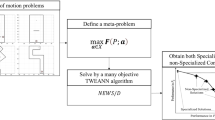Abstract
The objective of the work presented in this paper is to investigate the optimal learning strategy for snake-like modular robots using a (1+1) Evolutionary Algorithm. We take into account three different but correlated tasks: efficient locomotion, reaching a given point and obstacle avoidance.
Starting from earlier results on locomotion, we have performed three different sets of experiments. In the first, the snake must learn to go to a goal point, and we investigate how employing different fitness functions affect the learning of this task. In the second experiment the snake must learn how to avoid obstacles. In this experiment we test two possible behaviors, called mixed and switched strategies. Finally, in the third set of experiments, we introduce the concept of incremental learning and compare it with the “all-at-once” learning schemes of the first two experiments.
The results of the simulations indicates that the modular robots are able to learn both tasks with the (1+1) Evolutionary Strategy adopted, and that the fitness function that explicitly rewards each of the tasks perform better that the fitness function that takes into account the locomotion task only implicitly, rewarding only the reaching of the target point. We also demonstrate that the obstacles avoidance configuration with only one behaviour (mixed) is better than the configuration with two behaviours (switched) and that incremental learning provide a faster evolution towards good controllers.
Access this chapter
Tax calculation will be finalised at checkout
Purchases are for personal use only
Preview
Unable to display preview. Download preview PDF.
Similar content being viewed by others
References
Eiben, A., Kernbach, S., Haasdijk, E.: Embodied artificial evolution. Evolutionary Intelligence 5, 261–272 (2012)
Pérez-Moneo Suárez, D., Rossi, C.: Comparison between different evolutive configurations for learning basic functionalities. In: Proceedings of the 2013 European conference on Applications of Evolutionary Computation, EvoApplications 2013 (2013)
Pfeifer, R., Bongard, J.C.: How the Body Shapes the Way We Think. A New View of Intelligence. MIT Press (2007)
Ijspeert, A.: Central pattern generators for locomotion control in animals and robots: a review. Preprint of Neural Networks 21(4), 642–653 (2008)
Haasdijk, E., Rusu, A.A., Eiben, A.E.: HyperNEAT for locomotion control in modular robots. In: Tempesti, G., Tyrrell, A.M., Miller, J.F. (eds.) ICES 2010. LNCS, vol. 6274, pp. 169–180. Springer, Heidelberg (2010)
Clune, J., Beckmann, B.E., Ofria, C., Pennock, R.T.: Evolving coordinated quadruped gaits with the hyperNEAT generative encoding. In: Congress on Evolutionary Comutation (CEC) (May 2009)
Sims, K.: Evolving virtual creatures. Annual Conference Series, pp. 15–22 (July 1994)
Bongard, J.: Morphological change in machines accelerates the evolution of robust behavior. Proceedings of the National Academy of Sciences 108, 1234–1239 (2011)
Becerra, J.A., Bellas, F., Duro, R.J., Lope, J.D.: Snake-like behaviors using macroevolutionary algorithms and modulation based architectures
Weel, B., Haasdijk, E., Eiben, A.E.: The emergence of multi-cellular robot organisms through on-line on-board evolution. In: Di Chio, C., Agapitos, A., Cagnoni, S., Cotta, C., de Vega, F.F., Di Caro, G.A., Drechsler, R., Ekárt, A., Esparcia-Alcázar, A.I., Farooq, M., Langdon, W.B., Merelo-Guervós, J.J., Preuss, M., Richter, H., Silva, S., Simões, A., Squillero, G., Tarantino, E., Tettamanzi, A.G.B., Togelius, J., Urquhart, N., Uyar, A.Ş., Yannakakis, G.N. (eds.) EvoApplications 2012. LNCS, vol. 7248, pp. 124–134. Springer, Heidelberg (2012)
Lal, S., Yamada, K., Endo, S.: Evolving motion control for a modular robot. In: Ellis, R., Allen, T., Petridis, M. (eds.) Applications and Innovations in Intelligent Systems XV, pp. 245–258. Springer, London (2008)
Stanley, K., Bryant, B., Miikkulainen, R.: Real-time neuroevolution in the nero video game. IEEE Transactions on Evolutionary Computation 9(6), 653–668 (2005)
Eiben, A., Haasdijk, E., Bredeche, N.: Embodied, On-line, On-board Evolution for Autonomous Robotics. In: Levi, S.K.E.P. (ed.) Symbiotic Multi-Robot Organisms: Reliability, Adaptability, Evolution. Cognitive Systems Monographs, vol. 7, pp. 361–382. Springer (2010)
Bredeche, N., Haasdijk, E., Eiben, A.: On-line, on-board evolution of robot controllers. In: Collet, P., Monmarché, N., Legrand, P., Schoenauer, M., Lutton, E. (eds.) EA 2009. LNCS, vol. 5975, pp. 110–121. Springer, Heidelberg (2010)
Hirose, S., Morishima, A.: Design and control of a mobile robot with an articulated body. Int. J. Robot. Res. 9, 99–114 (1990)
Colorado, J., Barrientos, A., Rossi, C., Garzón, M., Galán, M., del Cerro, J.: Efficient locomotion on non-wheeled snake-like robots. In: Filipe, J., Andrade-Cetto, J., Ferrier, J.-L. (eds.) ICINCO (2), pp. 246–251. INSTICC Press (2010)
Author information
Authors and Affiliations
Corresponding author
Editor information
Editors and Affiliations
Rights and permissions
Copyright information
© 2014 Springer International Publishing Switzerland
About this chapter
Cite this chapter
Suarez, D.PM., Rossi, C. (2014). Evolutionary Learning of Basic Functionalities for Snake-Like Robots. In: Armada, M., Sanfeliu, A., Ferre, M. (eds) ROBOT2013: First Iberian Robotics Conference. Advances in Intelligent Systems and Computing, vol 252. Springer, Cham. https://doi.org/10.1007/978-3-319-03413-3_28
Download citation
DOI: https://doi.org/10.1007/978-3-319-03413-3_28
Publisher Name: Springer, Cham
Print ISBN: 978-3-319-03412-6
Online ISBN: 978-3-319-03413-3
eBook Packages: EngineeringEngineering (R0)




